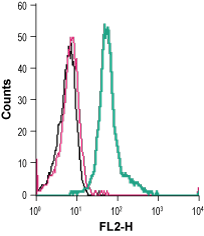Overview
- Peptide KDYPASTSQDSFEA(C), corresponding to amino acid residues 263-276 of human KV1.3 (Accession P22001). 1st extracellular loop.

 Cell surface detection of KV1.3 in human Jurkat T-cell leukemia cells:___ Cells.
Cell surface detection of KV1.3 in human Jurkat T-cell leukemia cells:___ Cells.
___ Cells + rabbit IgG isotype control-PE.
___ Cells + Anti-KV1.3 (KCNA3) (extracellular)-PE Antibody (#APC-101-PE), (5 µg). Cell surface detection of KV1.3 in mouse TK-1 T-cell lymphoma cells:___ Cells.
Cell surface detection of KV1.3 in mouse TK-1 T-cell lymphoma cells:___ Cells.
___ Cells + rabbit IgG isotype control-PE.
___ Cells + Anti-KV1.3 (KCNA3) (extracellular)-PE Antibody (#APC-101-PE), (5 µg).
- Chandy, K.G. et al. (2001) Toxicon 39, 1269.
- Koo, G.C. et al. (1997) J. Immunol. 158, 5120.
- Grissmer, S. et al. (1994) Mol. Pharmacol. 45, 1227.
- Garcia-Calvo, M. et al. (1993) J. Biol. Chem. 268, 18866.
- Garcia, M.L. et al. (1994) Biochemistry 33, 6834.
- Koschak, A. et al. (1998) J. Biol. Chem. 273, 2639.
- Kalman, K. et al. (1998) J. Biol. Chem. 273, 32697.
KV1.3 belongs to the Shaker family of voltage-dependent K+ channels. The channel, encoded by KCNA3, is widely expressed in the brain, lung and osteoclasts and in several cell populations of hematopoietic origin. The prominence of KV1.3 channels in these cells (particularly in T lymphocytes) directed much research attention. It was found that KV1.3 is the main channel responsible for maintaining the resting potential in quiescent cells and regulating the Ca2+ signaling that is indispensable for normal T lymphocyte activation.1,2 Based on the central role of KV1.3 in regulating the initiation of an immune response, the channel has been recognized as a potential target for immunosuppressant drugs.1
KV1.3 channels are potently inhibited by several venomous peptide toxins among them Charybdotoxin (2.6 nM), Noxiustoxin (1 nM), Kaliotoxin (0.65 nM), Margatoxin (0.05 nM), Agitoxin-1 (1.7 nM), Agitoxin-2 (0.004 nM), Hongotoxin-1 (0.09 nM) and Stichodactyla toxin (0.01 nM).3-7
The central role of KV1.3 in immune system cells created a real need for a specific antibody that would be able to work in flow cytometry applications.
Application key:
Species reactivity key:
Anti-KV1.3 (KCNA3) (extracellular) Antibody (#APC-101) is a highly specific antibody directed against an extracellular epitope of the human protein. The antibody can be used in western blot, immunohistochemistry, live cell imaging and indirect flow cytometry applications. It has been designed to recognize KV1.3 potassium channel from human, mouse and rat samples.
Anti-KV1.3 (KCNA3) (extracellular)-PE Antibody (#APC-101-PE) is directly conjugated to Phycoerythrin (PE). This labeled antibody can be used in immunofluorescent applications such as direct flow cytometry and live cell imaging.
